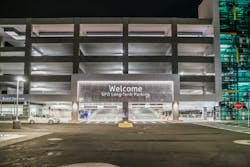With the number of vehicles expected to reach 2 billion by 2030, parking structures can be a transformative tool for improving the sustainability of buildings, communities and cities. Fifteen years ago, Shannon Sanders McDonald published a definitive book on the evolution of the American parking garage, The Parking Garage: Design and Evolution of a Modern Urban Form. In it she wrote, “Car parking is the urban planning issue of the modern era. As population growth is focused on cities, and as citizens vie for scarcer land, the multi-level parking garage is emerging as a modern elixir…The garage’s rising prevalence — and popular interest in a better urban environment overall — is yielding new garages whose style lifts their substance.”
Cities and urban planners have recognized the need to reconsider parking’s dominance in the landscape, and airports are now doing so, too. Without taking into account airport construction and operations, aviation accounts for approximately 2.5 percent of global greenhouse gas emissions. In the public policy sphere, airport sustainability is an area of interest, and aviation and airport communities also recognize the important role that airport infrastructure plays in promoting beneficial environmental and human health outcomes.
Airports’ Environmental and Sustainable Role
Airports contribute to local economies and employment. However, together with the socioeconomic benefits they offer, environmental costs and impacts are the inseparable results of the operation. Although there is little sustained research to date on their eco-footprint, airports are unquestionably the source of significant local pollution. To that end, and in response to communities’ concerns, public awareness of environmental issues of aviation activities and regulatory measures of local authorities and governments, airport authorities have been trying to apply strategies and procedures to diminish the adverse effects of their activities on the environment.
While airports will often upgrade terminals, there are many other sustainability initiatives that can be implemented. For example, in 2009, Boston Logan International Airport became the first U.S. airport to repave one of its runways with warm-mix asphalt, which has been used for years in Europe and which, according to Engineering News-Record, “produces nearly 4,000 fewer tons of carbon-dioxide emissions than traditional asphalt, about 400,000 fewer gallons of diesel fuel and an energy savings of about 53 billion BTUs.” To mitigate the toxicity of glycol-laced stormwater runoff, several north-latitude airports, including Buffalo Niagara International, have installed engineered wetlands — subsurface, aerated and earth-bermed gravel beds that filter pollutants on site.
Airport authorities also recognize the value of sustainable parking structures, which, in addition to their intrinsic value to the environment, can also enrich the user experience. By incorporating sustainable best practices into the architectural and functional design, and construction, parking structures can be aesthetically pleasing and easier to navigate.
Green Parking Structure Certification
In 2016, the U.S. Green Building Council (USGBC) announced it would administer the Green Garage Certification Program, now called Parksmart, through its acquisition of the Green Parking Council. This is the world’s only rating system defining and recognizing sustainable practices in parking structure management, programming, design and technology. At the time, Mahesh Ramanujam, COO of USGBC and president of GBCI – the certification body for USBGC – commented, “parking and sustainability are not mutually exclusive concepts. Every story about a green building is a story about people — and every story about parking is a story about connections between people and their community…Sustainability in parking is integral to the greening of the built environment.”
Lighting can help parking structures and buildings achieve sustainable certifications. While parking structures themselves may not be eligible for LEED certification, they can take part in the U.S. Energy Department’s Light Energy Efficiency in Parking initiative. When the campaign went widespread in 2014, participating partners were able to cut lighting-related energy use by an astounding 90 percent. The program encourages parking structures to switch to energy-efficient lighting and promotes lighting controls and smart technologies.
Beyond the basic attributes of form and function, getting to the next level of sustainability for parking garages means implementing more advanced and evolving technologies. This is exactly what was done at the newly constructed long-term garage at San Francisco International Airport (SFO).
Award-Winning San Francisco International Airport’s Newest Parking Structure On the road to NetZero
The recently completed six-story, 1.2 million-square-foot Long-Term Parking Garage has 3,600 stalls and incorporates innovative technologies to enhance the customer experience, while still meeting strict California energy codes. The $154.6 million parking garage is an iconic state-of-the-art facility and a much-needed addition for SFO. This project seamlessly ties into the adjacent existing long-term parking structure via a vehicular/pedestrian bridge, and connects to the AirTrain station and other airport facilities. The garage was divided into seismically separated structures maintaining a safe user experience while being located only a few miles from the San Andreas fault and situated on Bay Mud soils.
The project was constructed with a design-build model implementing innovative strategies. For example, to optimize the budget and schedule, the project incorporated Lean principles such as Pull-Planning and Choosing-By-Advantages workshops for strategic milestones or project elements. It also included co-location of core design-build team members throughout design and construction. This collaborative process resulted in turning the project over to SFO on budget and two months ahead of schedule.
The project aimed to elevate industry standards through sustainability. The thoughtful use of technology is intended to alleviate user stress, improve operations, reduce environmental impact and ready the garage to adapt to future needs based on auto trends and economic forecasting. The structure features an automated parking guidance system that signals drivers about the availability of stalls, an access- and revenue-control system for reserved parking, and a “find my car” function at the pay stations. The structure is 100 percent Wi-Fi accessible, and the team installed backbone conduit risers to accommodate future improvements in cell phone coverage.
The garage contains 108 electric vehicle charging stations — nearly three percent of all parking stalls — with infrastructure for 252 more as demand increases. Solar panels cover the roof, which creates a net-energy-positive system that powers the entire building. The garage has earned Parksmart certification.
Contributing to the facility earning this certification is a thoughtful lighting design that includes luminaires that prioritize the user experience. The project required the luminaires be controls-agnostic, highly efficient and highly efficacious, and be delivered on time and within budget.
To meet these challenges, Max Pierson-Lienard of Miniscule Lighting selected Kenall’s SenScape SPG18 LED luminaires, which incorporate an up-light feature to eliminate the “cave effect” often associated with parking garage lighting. This improves the contrast ratios and overall appeal of the structure. Each of the 824 installed luminaires throughout the structure are compatible with third-party controls, and also include an embedded image sensor for car counting and a textured tertiary lens for glare reduction.
For many SFO travelers, this new parking structure is their first and last impression of the airport. The purposeful design and complementary lighting have made it a winner among travelers. Judges also concur as evidenced by the almost one dozen awards it has won, including a comment from a judge at the 2019 Engineering News Record-California project competition who stated, “The best parking garage I’ve ever seen.”
Lynn Walldorf is a mechanical engineer focused on the development of customer-centric lighting products for almost 20 years. She is currently the product marketing manager at Kenall Manufacturing and may be reached at [email protected]. Kenall was founded in Chicago, Illinois in 1963 and has built a reputation for durable lighting solutions of superior quality and exceptional value. Today, the company creates unique solutions for the parking, healthcare, cleanroom/containment, food processing, transportation, high abuse, and correctional lighting markets. Kenall luminaires are designed in Kenosha, Wisconsin, and comply with the Buy American Act (manufactured in the United States with more than 50% of the component cost of US origin).






